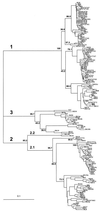Molecular and biophysical characterization of TT virus: evidence for a new virus family infecting humans
- PMID: 10077657
- PMCID: PMC15915
- DOI: 10.1073/pnas.96.6.3177
Molecular and biophysical characterization of TT virus: evidence for a new virus family infecting humans
Abstract
The recent isolation of a novel DNA virus from the serum of a Japanese patient (T.T.) has provided the latest possible candidate virus associated with cryptogenic hepatitis. In the present study, we report the complete nucleotide sequence of this virus (TTV) isolated from the serum of a West African. Based on PCR studies designed to amplify overlapping regions of the viral genome and sensitivity to digestion with mung bean nuclease, the viral genome is circular and negative stranded, and comprises 3,852 nt, which is 113 nt longer than the prototype isolate from Japan. Cesium chloride density gradient centrifugation demonstrated banding of the virus at 1.31-1.34 g/ml; filtration studies indicated that TTV had a particle size of 30-50 nm. These results suggest that the virus is similar to the Circoviridae, viruses known to infect plants and vertebrates (e. g., birds and swine); however, sequence similarity searches of available databases did not reveal identity between TTV and other viruses. Phylogenetic analyses of a 260-nt region from 151 globally distributed isolates demonstrated the existence of three major TTV genotypes. Several individuals at high risk for infection with parenterally transmitted viruses were infected with more than one genotype. There was no correlation between genotype and geographic origin. Finally, intravenous inoculation of TTV-positive human serum into chimpanzees demonstrated that TTV can be transmitted to primates; no biochemical or histological evidence for hepatitis was obtained. The distinct biophysical and molecular characteristics of TTV suggest that it is a member of a new family of viruses, which we have tentatively named the Circinoviridae.
Figures



References
-
- Nishizawa T, Okamoto H, Konishi K, Yoshizawa H, Miyakawa Y, Mayumi M. Biochem Biophys Res Commun. 1997;241:92–97. - PubMed
-
- Okamoto H, Nishizawa T, Kato N, Ukita M, Ikeda H, Iizuka H, Miyakawa Y, Mayumi M. Hepatol Res. 1998;10:1–16.
-
- Okamoto H, Akahane Y, Ukita M, Fukada M, Tsuda F, Miyakawa Y, Mayumi M. J Med Virol. 1998;56:128–132. - PubMed
-
- Desai, S. M., Muerhoff, A. S., Leary, T. P., Erker, J. C., Simons, J. N., Chalmers, M. L., Birkenmeyer, L. G., Pilot-Matias, T. & Mushahwar, I. K. (1999) J. Infect. Dis., in press. - PubMed
-
- Charlton M, Adjei P, Poterucha J, Zein N, Moore B, Therneau T, Krom R, Weisner R. Hepatology. 1998;28:839–842. - PubMed
MeSH terms
Associated data
- Actions
- Actions
- Actions
- Actions
- Actions
- Actions
- Actions
- Actions
- Actions
- Actions
- Actions
- Actions
- Actions
- Actions
- Actions
- Actions
- Actions
- Actions
- Actions
- Actions
- Actions
- Actions
- Actions
- Actions
- Actions
- Actions
- Actions
- Actions
- Actions
- Actions
LinkOut - more resources
Full Text Sources
Other Literature Sources
Research Materials

